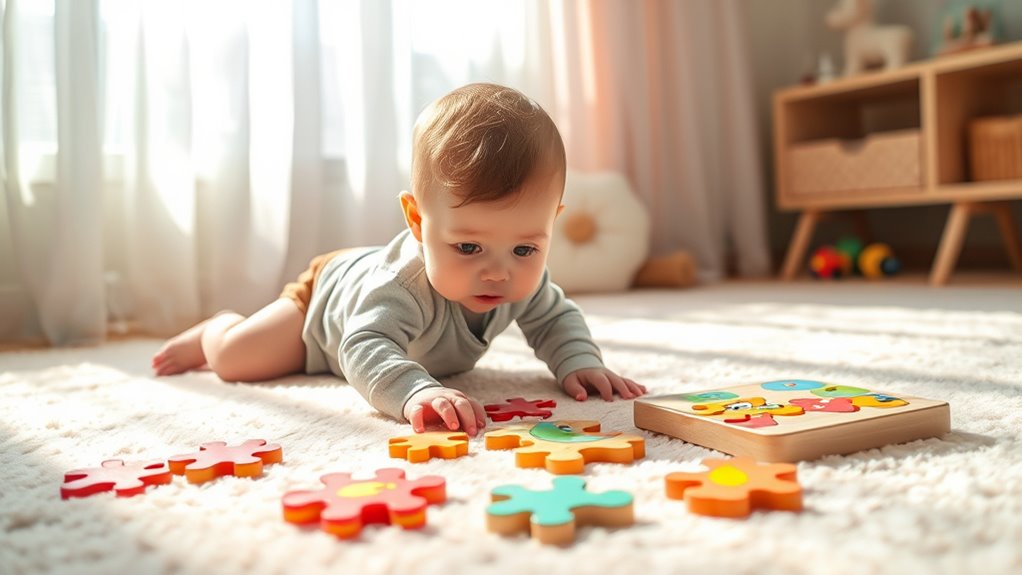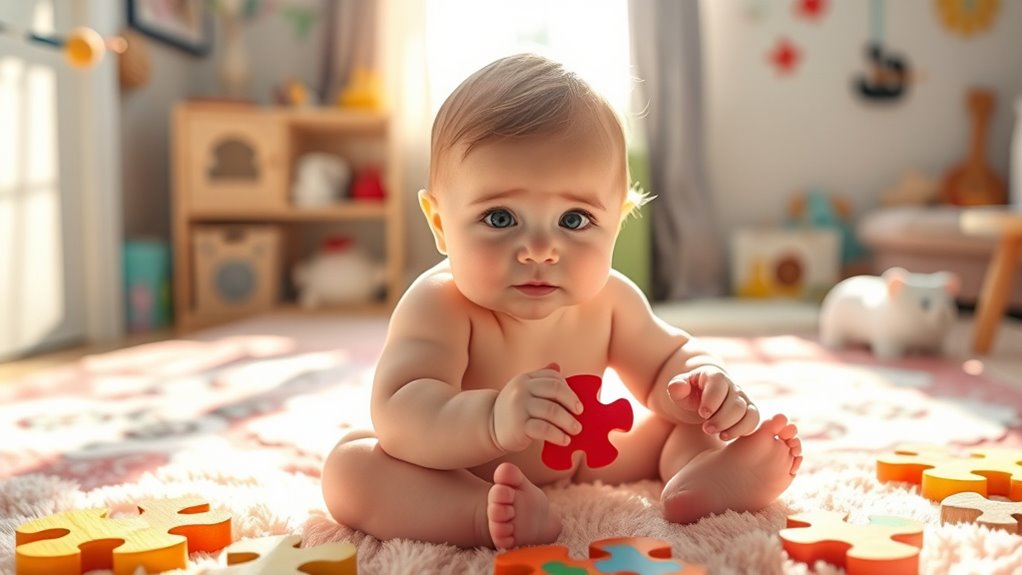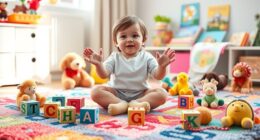Starting simple with puzzles is crucial for your baby’s development. From around six months, you can introduce one-piece puzzles, gradually moving to multi-piece shapes by 13 to 15 months. These activities help enhance fine motor skills, hand-eye coordination, and problem-solving abilities. Choose age-appropriate puzzles with vibrant colors and engaging themes to keep their interest. As you explore different puzzles together, you’ll also foster social skills and connection. There’s so much more to learn about maximizing playtime with puzzles!
Key Takeaways
- Begin with simple one-piece puzzles for babies around six months to develop fine motor skills and hand-eye coordination.
- Introduce multi-piece puzzles with basic shapes between 13 to 15 months to enhance problem-solving and cognitive abilities.
- At 18 months, incorporate puzzles featuring geometric forms or animals to boost visual perception and spatial awareness.
- Gradually transition to simple jigsaw puzzles at two years old to encourage more complex problem-solving and social interactions.
- Prioritize age-appropriate puzzles with safety features and engaging designs to maintain interest and ensure safe play experiences.

At around six months, your baby can start exploring the world of puzzles, and this playtime activity offers a wealth of developmental benefits. Initially, simple one-piece puzzles are perfect for your little one. At this age, they might even mouth the pieces, which is a normal part of their sensory exploration. These early encounters help improve fine motor skills as your baby learns to grasp and manipulate the pieces, laying the groundwork for more complex tasks down the line.
As your baby grows, around 12 months, they’ll develop the pincer grasp, enabling them to remove and fit puzzle pieces more effectively. This increase in dexterity enhances their hand-eye coordination, as they learn to coordinate what they see with their movements.
Around 13 to 15 months, multi-piece puzzles featuring simple shapes become exciting challenges. These puzzles encourage problem-solving skills, as your toddler experiments with different pieces to find the right fit, fostering resilience as they learn through trial and error.
By 18 months, you can introduce puzzles with different shapes, such as geometric forms or animal figures. This not only boosts their visual perception but also enhances spatial awareness, helping them understand how objects fit together and relate to one another in space.
At two years old, simple jigsaw puzzles can be introduced, further developing their cognitive skills while keeping the playtime engaging.
Puzzles also play a significant role in building social skills. When your child engages in puzzle play with others, they develop empathy and communication skills. Working together on puzzles encourages teamwork and collaboration, teaching them how to rely on others while sharing the joy of completing a task.
These interactions promote both verbal and non-verbal communication, essential skills as they grow. Additionally, engaging in safe sleep environments is important for your child’s overall development and well-being.
Choosing the right puzzle is crucial for maximizing these benefits. Look for puzzles that match your child’s age and ability while ensuring safety features are in place—no sharp edges, please!
Opt for bright colors and engaging themes to keep their interest piqued. As they navigate the world of puzzles, your baby won’t only have fun but also develop essential skills that will serve them well throughout their early years. By starting simple and gradually progressing to more complex puzzles, you’ll nurture their growth in a playful, enriching way.
Frequently Asked Questions
What Age Is Appropriate to Start Introducing Puzzles to Babies?
You can start introducing puzzles to your baby around 6 to 10 months, depending on their development.
At this age, simple inset-type puzzles with minimal pieces are perfect. Look for puzzles that are large enough to prevent choking hazards and made from safe materials like wood.
High-contrast visuals will catch your baby’s attention, making puzzle play both fun and beneficial for their fine motor skills and cognitive development.
How Do I Choose the Right Puzzle for My Baby?
When choosing the right puzzle for your baby, consider their age and developmental stage.
Opt for knob or peg puzzles made from safe materials, ensuring the pieces are large enough to prevent choking.
Look for high-contrast visuals to capture their attention and start with simple designs that have few pieces to avoid frustration.
Keep it engaging but not overwhelming, and monitor their progress to adjust the puzzle complexity as they grow.
Are Wooden Puzzles Better Than Cardboard Ones for Babies?
You won’t believe how much better wooden puzzles are than cardboard ones for your little one!
They’re tough as nails, last for generations, and are safer with larger pieces that won’t pose choking hazards.
Plus, they boost fine motor skills and cognitive development like a charm!
The tactile experience is delightful, and they support sensory growth.
How Can I Encourage My Baby to Play With Puzzles?
To encourage your baby to play with puzzles, start with simple, colorful designs that capture their interest.
Sit with them and demonstrate how to fit the pieces together, making it a fun bonding activity.
Use positive reinforcement by celebrating their attempts, even if they don’t succeed right away.
Gradually introduce more challenging puzzles as they gain confidence and skills.
Always keep the atmosphere playful, ensuring they associate puzzles with enjoyment and exploration.
What Are the Benefits of Puzzle Play for a Baby’s Development?
Puzzle play offers numerous benefits for your baby’s development. It enhances problem-solving skills and memory, while also fostering pattern recognition and spatial awareness.
As your little one manipulates pieces, they’re improving fine motor skills and hand-eye coordination. Emotionally, puzzles teach patience and boost self-confidence upon completion.
Socially, working together on puzzles encourages teamwork and communication. Overall, puzzle play lays a solid foundation for cognitive, physical, and emotional growth in your baby’s early years.
Conclusion
As you watch your baby piece together a simple puzzle, it’s like witnessing the first strokes of a masterpiece. Each time they fit a piece, it’s a small victory, building not just their skills but their confidence. Research shows that engaging in puzzles can boost cognitive development by 30%. So, embrace these moments; they’re laying the foundation for problem-solving skills that will serve them throughout life, turning tiny triumphs into the building blocks of a bright future.









